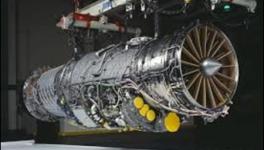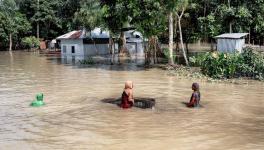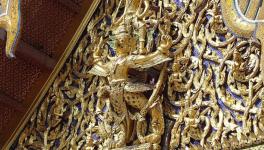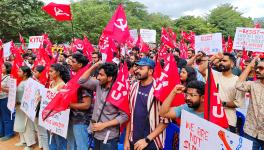In My Own Voice: Heroes or Hiroshima?

Image Courtesy: Sciences Po
On February 27, the IAF claims, the pilot, Abhinandan Varthman, got into a dogfight with an F 16 plane on Pakistan airspace and ejected. He was captured by the Pakistan military and a video of him answering questions with calm, unhindered spirit, was released. What is less known is that missiles were ready on both the sides of the border, and that hotlines were connected with the United States. India wanted its pilot released safely, and did successfully procure him, but let us remember that in war, the truth is the first casualty; what we learn is what they want us to hear.
The fact that India’s conventional army has superior military capability than Pakistan, could mean that Pakistan resorting to a nuclear attack is more likely. However, Pakistan has consistently refused to sign a ‘no first use’ pact, for it claims if there is a threat of annihilation, it has the right to use its nuclear weapon.
No one quite knows what exactly was destroyed at Balakot and if anyone dare raise a question, they are threatened, and are accused of disregarding the supreme sacrifice of the armed forces. Meanwhile, the drum-beaters of the political party in power and its media acolytes give us ‘manufactured news stories’, which pass as the truth today.
In this context, it would be appropriate to remember the work of Australian journalist Wilfred Burchett – the first journalist to get to Hiroshima after the US destroyed the Japanese city by detonating an atomic bomb over it in 1945. His report blazed across the London ‘Daily Express’ with the subheading: ‘I Write This as a Warning to the World’.
Burchett wrote from ground zero, “In these hospitals, I found people who, when the bomb fell suffered absolutely no injuries, but are now dying from the uncanny after-effects. For no apparent reason, their health began to fail. They lost appetite. Their hair fell out. Bluish spots appeared on their bodies. And then bleeding began from the ears, nose and mouths… And in every case, the victim died. That is one of the aftereffects of the atomic bomb and I do not want to see any more examples of it.”
Burchett also wrote: “My nose detected a peculiar odour unlike anything I have smelled before… I could also smell it when everything was deserted. They believe it is given off by the poisonous gas still issuing from the earth soaked with radioactivity by the split uranium atom. … Hundreds upon hundreds of the dead were so badly burned in the terrific heat generated by the bomb that it was not even possible to tell whether they were men or women, old or young. Of thousands nearer the centre of the explosion, there was no trace. They vanished. The theory in Hiroshima is that the atomic heat was so great that they burned instantly to ashes – except that there are no ashes.”
Also read: In My Own Voice: Grief Has No Borders
During his 1971 visit to Hiroshima, Burchett found it beautifully rebuilt with parks and a museum, and said so in his speech. He later met with a hibakusha (victim of the Hiroshima tragedy) who told him that one in four children of the first-generation victims had birth defects, as documented by the Yamaguchi study. Ms Hasegawa, who was born in the year of the bombing, castigated Burchett for being pleased by the outward appearance of Hiroshima. She explained that they suffered chronic weakness and extreme lassitude, ensuring that no one would hire a hibakusha and also no one wanted to marry a hibakusha for the fear of birth defects. This created serious psychological problems for them, and they were, in fact, the world’s new untouchables.
While Burchett had his press accreditation taken away for his writings on Hiroshima, he said that he was too overwhelmed to even question the cool planning that went into the subsequent cover-up. For instance, why did he, as an accredited war correspondent, have difficulty in transmitting his report to a newspaper? Why did he receive such hostility from military authorities in Tokyo? Why was he whisked away to a military hospital – perhaps in an attempt to isolate him from his colleagues who were more involved in witnessing the handing-over ceremony? And how did his camera with the roll of photographs taken in Hiroshima get stolen? These are just some questions he raised years later.
In contrast, there is another much feted journalist, William L Lawrence, who was a member of the US journalists’ delegation, and was the science writer for many years for the New York Times. Burchett revealed that he wore two hats: he was also a ‘member of the inner circle of the government’s nuclear weapons directorate’. He was recruited by Leslie Groves, the commander of the Manhattan project, as the ‘news manager’. Burchett said that given the years of voluntary press censorship on the mention of atomic energy and the general scientific ignorance of wartime journalists, Lawrence became the mouthpiece. For his service towards the US government – including drafting Truman’s statement on Hiroshima – he was awarded the Pulitzer prize and a War Department commendation.
Not much has changed: one only has to look at the war-drumming machinery – at our various media channels – to recognise the existence of several Lawrences – journalists and media managers who are, and will be further rewarded with plum assignments and honours. While Burchett was ostracised by his government and even had his accreditation taken away from him, witness what journalists like Ravish Kumar and others are facing right now.
War is always a series of miscalculations in which the masses have to endure the horrific pain in silence lest the nation loses its glory. Those who celebrate war never participate in it and those who participate in it never ever celebrate it. And war is always an accident: it was the assassination of Archduke Ferdinand that led to the World War I.
After Hiroshima and Nagasaki, the world has been close to using nuclear weapons nine times: in the Cuban missile crisis, missed radar warnings and other accidents that sound like sci-fi if they were not so horrifically serious.
Just after Pokhran two I was at Sabarmati ashram in the early hours of the morning. As a writer and a filmmaker, I was walking around in the early morning light to assess where we would be filming when I heard some loud sounds, and went to check what was happening. I saw Gandhi’s words against nuclear warfare being dismantled and put away into crates; visitors to the museum have an edited version of Gandhi’s concepts of ahimsa. The threat of nuclear war is real and we need to reclaim the idea of India and talk peace with our neighbours.
This is not to put down Abhinandan, but we do need to ponder. Are our real heroes those who are fighting for peace, or those who are propelling us towards becoming the state of Hiroshima?
Also read: In My Own Voice: Heroes, Neros and Zeroes
Sagari Chhabra is an award-winning author and a film director.
Get the latest reports & analysis with people's perspective on Protests, movements & deep analytical videos, discussions of the current affairs in your Telegram app. Subscribe to NewsClick's Telegram channel & get Real-Time updates on stories, as they get published on our website.























